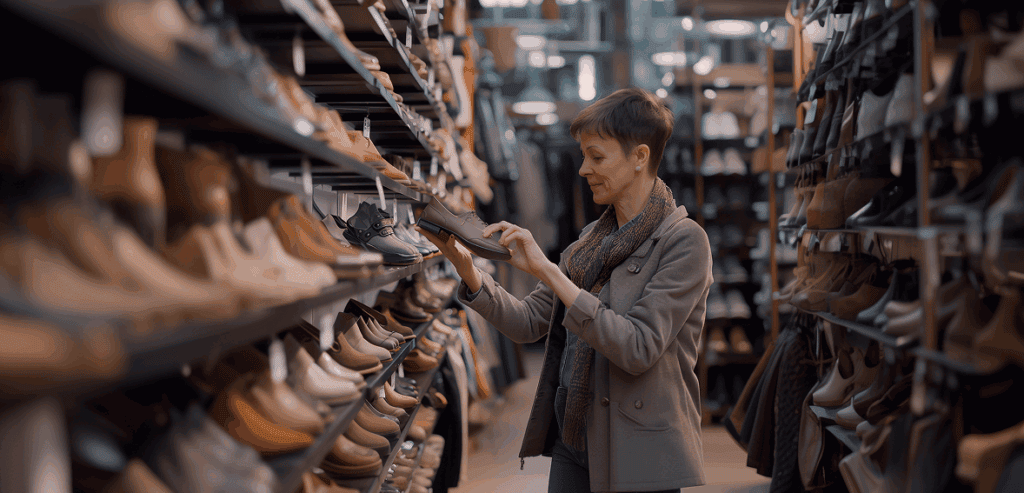
By Pamela Thompson April 22, 2025
Footwear is a necessity, but it’s also a fashion statement. While shoes are purchased year-round, transaction volume in footwear sales tends to fluctuate with the seasons. Whether it’s the back-to-school rush in August or the slow crawl of January sales, seasonal trends significantly impact how much inventory moves, when consumers are shopping, and which types of shoes are in demand.
For footwear retailers—whether they operate online, in physical stores, or both—understanding how seasons affect customer behavior is essential. These patterns influence everything from marketing and staffing to inventory management and pricing strategy.
Understanding Seasonality in Retail
Seasonality refers to recurring changes in sales volume that happen at specific times during the year. In retail, seasonality can result from weather patterns, holidays, school schedules, or cultural events. Footwear, being both a functional and fashionable product category, is particularly sensitive to these cyclical trends.
While it’s normal for sales to rise and fall across the calendar, what matters most is how retailers respond. The key to managing seasonality is preparation—knowing when sales are likely to rise or drop and adjusting operations accordingly.
What Makes Footwear Seasonally Sensitive?
Unlike food or basic household supplies, shoes aren’t always a recurring weekly need. Many consumers make footwear purchases around specific life events or conditions. For example, new athletic shoes might be bought for a fitness resolution in January, while sandals see a sales boost as summer approaches.
Seasonal weather, fashion launches, school terms, and holiday shopping periods all combine to create predictable transaction patterns in the footwear industry.
Major Seasonal Highs in Footwear Sales

Understanding the busiest times of year for footwear sales is the first step in managing demand effectively. Each peak season has its own characteristics and customer expectations, and smart retailers know how to capitalize on these moments.
Back-to-School Season (July to September)
The back-to-school period is one of the most significant sales drivers for the footwear industry. Parents shop for children’s school shoes, gym sneakers, and casual wear as students prepare for the new academic year. Retailers often see spikes in both in-store and online traffic during this time.
Promotions are common during this period, and consumers often look for affordability, comfort, and durability. Transaction volume increases substantially, especially for children’s footwear and popular athletic brands.
Holiday Shopping Season (November to December)
Black Friday, Cyber Monday, and the lead-up to Christmas are packed with promotions. Shoppers are not just buying for themselves but also purchasing gifts, which often include high-end or trend-driven footwear. From boots to limited-edition sneakers, demand can spike sharply in these months.
During this time, transaction volume surges, and competition between retailers is high. Delivery timelines, customer service, and return policies all come under scrutiny as consumers expect fast, reliable experiences.
Spring/Summer Kickoff (March to May)
As temperatures rise, shoppers begin transitioning from cold-weather gear to warm-weather shoes. Sandals, lightweight sneakers, and casual slip-ons become more popular, especially as vacations and outdoor activities increase.
Retailers often plan their spring launches in March or April, leading to an increase in both traffic and sales. Promotions tied to holidays like Easter or Mother’s Day can also contribute to higher transaction volume.
Seasonal Slumps and Low Sales Periods
While some months bring booming business, others are slower. Recognizing these periods helps retailers control expenses, manage staffing, and plan marketing strategies to drive engagement.
Post-Holiday Slowdown (January)
After the surge of holiday shopping, January tends to be slower for most footwear retailers. Many consumers are recovering from holiday spending or taking advantage of gift cards rather than making new purchases.
This is often a time for clearance sales or heavy markdowns. While margins may be slimmer, these strategies help clear old inventory and make way for spring collections.
Midsummer Lull (Late June to Early July)
While summer starts strong for sandals and casual shoes, there’s often a noticeable dip in late June and early July. Vacations, unpredictable weather, and a temporary pause between major shopping events can all contribute to a slowdown.
Retailers sometimes use this quieter period to prepare for the back-to-school rush and fine-tune inventory plans.
The Impact of Weather on Shoe Sales
Weather plays a major role in shaping footwear purchases. It’s not just about the seasons but also about specific temperature changes, rainfall, and unexpected weather patterns that influence customer behavior.
Cold Weather Boosts Boots and Warm Footwear
When the first cold snap hits, shoppers rush to purchase winter boots, insulated sneakers, and waterproof shoes. Retailers that time their winter product drops correctly can see a fast increase in transactions.
Conversely, warm winters or delayed snowfalls can result in unsold stock or slow-moving inventory, especially in colder climates.
Heat Spurs Demand for Open-Toe and Breathable Styles
As temperatures rise, customers switch to breathable, open-toe, and lighter-weight footwear. This includes sandals, espadrilles, and running shoes designed for summer use.
Sudden heatwaves or extended warm spells can accelerate this transition. Retailers who react quickly with updated displays and online promotions can capture this increased demand.
How Cultural and Lifestyle Events Influence Sales
Footwear sales don’t just follow the seasons—they also track closely with cultural trends and events. For example, a highly anticipated sneaker drop or a celebrity endorsement can trigger a rush of transactions, even outside typical seasonal peaks.
Fitness Trends and New Year Resolutions
Every January, gyms see an influx of new members, and athletic shoe purchases rise alongside. Workout programs, running clubs, and fitness influencers also drive consumers toward performance footwear.
Retailers often use this opportunity to highlight athletic collections, offer bundle deals, or partner with local gyms for co-branded promotions.
Graduation and Wedding Seasons
From late spring through early summer, social events like graduations and weddings influence footwear purchases. Consumers look for formal shoes, heels, or occasion-specific styles, often shopping both in-store and online.
Transaction volume in these categories may not be as high as back-to-school, but margins are often better due to higher average order values.
Inventory and Staffing Adjustments by Season
Because transaction volume fluctuates throughout the year, shoe retailers must adapt their operations accordingly. This includes changes in how they manage inventory, staff, and customer service.
Inventory Planning
Retailers must plan inventory several months in advance, using past seasonal data to predict demand. Orders for fall and winter shoes are often placed in late spring, while spring and summer lines are locked in by autumn of the previous year.
Holding too much stock during off-peak times can tie up cash flow, while too little inventory during high season results in missed opportunities. POS systems with analytics and forecasting tools can help retailers strike the right balance.
Seasonal Hiring
Staffing also needs to flex with the season. More employees are typically needed during high-traffic times such as December or August. Temporary or seasonal workers are common in the footwear industry, especially in larger retail environments.
Proper training and onboarding are essential to ensure seasonal workers understand the brand and can handle high customer volumes efficiently.
Marketing Strategies to Match Seasonal Trends
Sales success in footwear retail often hinges on well-timed promotions and targeted messaging. Seasonal marketing not only helps drive transactions but also builds anticipation and brand engagement.
Time-Limited Promotions
Creating urgency is especially effective during short-lived seasons. A limited-time sale on boots before winter hits, or a “Summer Essentials” campaign highlighting sandals and sneakers, can drive quick conversions.
Timing these campaigns right before the season begins ensures shoppers are thinking about their upcoming needs.
Event-Based Campaigns
Retailers can align their campaigns with calendar events, such as Valentine’s Day, Father’s Day, or school reopenings. These events offer built-in themes for creative promotions and encourage customers to shop with a purpose.
Social media and email marketing are powerful tools for building seasonal excitement and encouraging engagement before key sales periods.
Online vs In-Store Sales: Seasonal Differences
Different seasons can also shift customer preferences between shopping online and in-store. Understanding how these patterns change allows retailers to optimize both channels accordingly.
Cold Months Push Online Traffic
During winter months, especially in regions with harsh weather, consumers tend to shop online more often. Retailers should ensure their websites are mobile-friendly, stocked with current inventory, and equipped with flexible delivery options.
Offering perks like free returns or try-at-home programs can reduce hesitation during online purchases.
Spring and Summer Drive Foot Traffic

Warmer weather encourages in-store visits. Shoppers may combine shoe shopping with other errands or simply enjoy browsing in person. During this time, creating appealing in-store displays, running local ads, and offering in-store-only deals can maximize conversion rates.
For omnichannel retailers, making inventory visibility clear across both platforms helps customers decide where and how they want to shop.
Adapting to Changing Consumer Behavior
While seasonal trends have traditionally shaped footwear sales, changing consumer habits—like year-round online shopping or climate-resilient lifestyles—are shifting the landscape.
Retailers must be flexible in responding to these changes. Data from past seasons is still useful, but it’s equally important to monitor real-time trends, emerging preferences, and feedback across platforms.
Incorporating customer reviews, investing in trend forecasting tools, and following fashion influencers can help identify what’s gaining traction, even if it’s outside the traditional seasonal calendar.
Conclusion
Seasonal trends will always play a significant role in shaping transaction volume within the footwear industry. From back-to-school shopping sprees to post-holiday slowdowns, understanding these fluctuations allows shoe retailers to plan better, market smarter, and serve customers more effectively.
Success comes from preparation—forecasting demand, adjusting staffing, launching timely promotions, and aligning inventory with expected spikes and dips. By embracing the patterns of each season and staying responsive to customer behavior, footwear businesses can turn seasonal changes into steady opportunities for growth and customer connection.
Leave a Reply